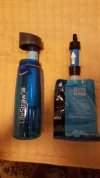I got giardiasis, a form of dysentery, on my last camino. It seems likely that I acquired it in the Sorian uplands, or possibly in Aragón - it can, and in my case did, take several weeks to incubate, so I have no idea whether I got it from water or from food. It is highly unlikely that I got it from another pilgrim, as I saw none between the Mediterranean and Burgos. Recent studies suggest that it is one of the reasons the Christians lost the Crusades, as it appears to have been endemic in the invading armies.
In the UK it is a notifiable disease, but so far my case has proved resistant to two doses of antibiotics, and I am currently on a course of albendazole, which the local microbiologist hopes will finally get rid of the little beasties for me. I was fortunate in that I suffered relatively few ill-effects from it; my wife, whom I infected on my return from Spain, was much less fortunate, and has suggested that I leave any passengers behind on my next pilgrimage.
























